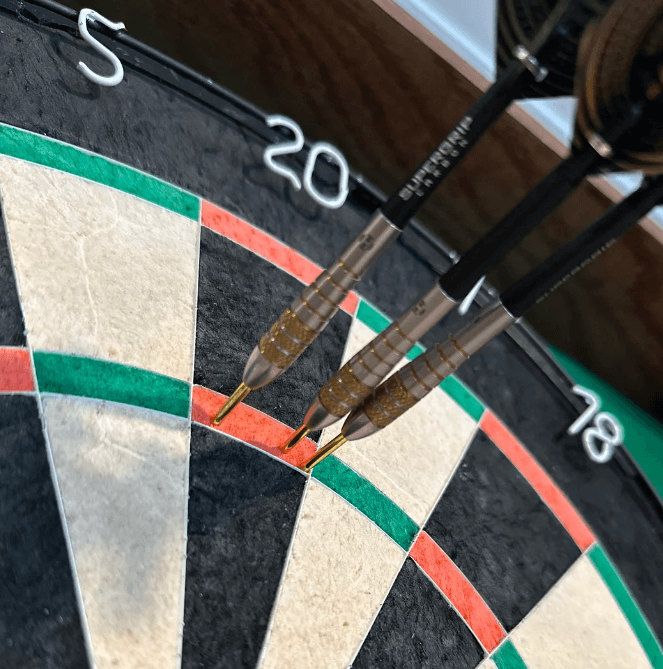Darts is more than just a game played in pubs; it’s a world of rich history, unique personalities, and intense competition. For those who play or watch darts regularly, there’s always something new to learn. From surprising origins to record-breaking achievements, here are ten intriguing facts that every darts fan/enthusiast should know.
1. Darts Began as a Military Pastime
The game of darts dates back to medieval England, where soldiers would pass time between battles by throwing spearheads or arrows at barrel tops or tree trunks. Over time, these impromptu games evolved into what we now know as darts, complete with dartboards and standardized rules.
2. The Dartboard’s 20 on Top Wasn’t Always Standard
It’s hard to imagine a dartboard without the number 20 at the top. However, this was established by Brian Gamlin, a Lancashire carpenter, in 1896. Before that, dartboards featured numbers in various sequences. Gamlin’s layout is still used today, and the arrangement requires both accuracy and strategy, making it a true test of skill.
3. Phil Taylor Holds an Incredible 16 World Titles
Phil “The Power” Taylor is considered by many to be the greatest darts player of all time, with an astonishing 16 World Championships under his belt. His dominance through the ’90s and early 2000s helped popularize darts and brought more attention to the sport than ever before.

4. The First Televised 9-Dart Finish was a Moment in History
The “nine-darter” is the holy grail of darts—a perfect leg of 501 completed in just nine throws. The first-ever televised nine-dart finish was achieved by John Lowe in 1984. It not only earned him a spot in the darts hall of fame but also a substantial cash prize, as it was a feat thought nearly impossible at the time.
5. Darts Almost Didn’t Make it Out of the Pubs
In 1908, a pub owner named William “Bigfoot” Anakin was taken to court for hosting darts games. At the time, British authorities considered darts a game of chance, much like gambling. Anakin famously defended the game by demonstrating its skill-based nature in court, hitting a chosen number three times in a row. The court ruled in his favor, and darts was legally recognized as a game of skill.
6. Professional Players Can Score Over 100 Points with Consistency
While it may sound simple, consistently scoring over 100 points per turn is an achievement that separates professional players from amateurs. These “ton-plus” scores (three darts totaling 100 points or more) require a high level of accuracy and precision. In a professional match, most players average well above 100 points per turn, an impressive display of skill.
7. The Highest Score You Can Hit with Three Darts is 180
A perfect score of 180, or “ton-eighty,” is achieved when all three darts land in the triple 20. This feat requires pinpoint precision, and hearing the crowd roar after a 180 is one of the most thrilling moments in darts. Players often hit multiple 180s per match, and in some high-profile matches, players have managed to hit over 20!

8. Darts Is Now Played All Over the World
Darts may have originated in England, but it has since spread across the globe. The Professional Darts Corporation (PDC) hosts events in countries like Germany, the Netherlands, Australia, and even Japan. The World Darts Championship draws viewers from around the world, and many countries now have their own leagues and championships.
9. Nine Darts Isn’t the Only “Perfect Game”
While a nine-darter is the most recognized perfect game, other formats have their version of perfection too. In a game of “cricket,” which is a popular alternative format, closing all required numbers and bullseyes in the minimum throws is considered a perfect game. Each format has its own “perfect finish,” showcasing the diversity and depth within the sport.
10. Darts Has a Nickname Tradition that Rivals Wrestling
One of the most entertaining aspects of darts is the use of nicknames, which has become an integral part of the sport’s culture. Some nicknames reflect personality, like Peter “Snakebite” Wright, while others emphasize power, like Phil “The Power” Taylor. The tradition of nicknames adds flair and excitement, with fans often chanting these names in support.
Conclusion
These ten facts reveal just how multifaceted the sport of darts really is, blending skill, history, and a passionate fan culture. Whether you’re just getting into darts or are a longtime fan, knowing more about the game’s quirks and legends adds to the enjoyment of every match. So next time you’re at the oche, remember that you’re part of a tradition that dates back centuries, filled with champions, legends, and fans who all share a love for the game.





